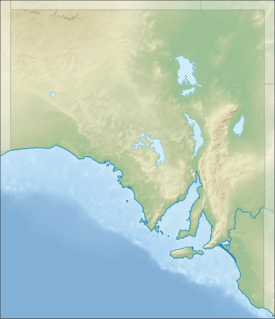Billiatt Conservation Park
| Billiatt Conservation Park South Australia | |
|---|---|
|
IUCN category Ia (strict nature reserve) | |
 Billiatt Conservation Park | |
| Nearest town or city | Alawoona |
| Coordinates | 34°59′20″S 140°28′52″E / 34.98889°S 140.48111°ECoordinates: 34°59′20″S 140°28′52″E / 34.98889°S 140.48111°E |
| Established | 12 December 1940[1] |
| Area | 802 hectares (1,980 acres)[1] |
| Managing authorities | Department of Environment, Water and Natural Resources |
| See also | Protected areas of South Australia |
Billiatt Conservation Park is a protected area in South Australia midway between Alawoona and Lameroo, approximately 200 km east of Adelaide city centre.
Description
The country is characterised by sand dunes with a mosaic of open mallee scrub. Ridge-fruited and red-tipped slender leaf mallees add colour to the dunes with broombush growing in the mottled shade.[2]
The conservation park is classified as an IUCN Category Ia protected area.[3]
The conservation park occupies in land in the gazetted locality of Sandalwood.[4]
Fauna
Pygmy possums and eighteen species of reptile inhabit the park.[5]
Recognition by non-government organisations
Billiatt Conservation Park is part of an area of land considered by BirdLife International to be an Important Bird Area because it contains small but globally important populations of malleefowl, mallee emu-wren and purple-gaped honeyeater, as well as the rare western whipbird and red-lored whistler.[6]
See also
References
- 1 2 "Protected Areas Information System - reserve list (as of 25 November 2014)" (PDF). Department of Environment, Water and Natural Resources. Retrieved 8 January 2015.
- ↑ Dept. of Environment and Natural Resources website Archived December 29, 2010, at the Wayback Machine.
- ↑ "Terrestrial Protected Areas of South Australia (see 'DETAIL' tab)". CAPAD 2012. Australian Government - Department of the Environment. 6 February 2014. Retrieved 6 February 2014.
- ↑ "Search result for " Billiatt (Locality Bounded)" (Record no SA0050280) with the following layers selected - "Suburbs and Localities" and "Local Government Areas"". Department of Planning, Transport and Infrastructure. Retrieved 13 April 2016.
- ↑ "IBA: Billiat". Birdata. Birds Australia. Archived from the original on 2011-07-06. Retrieved 2011-05-18.
- ↑ "Important Bird Areas factsheet: Billiatt". BirdLife International. 2015. Retrieved 11 January 2015.